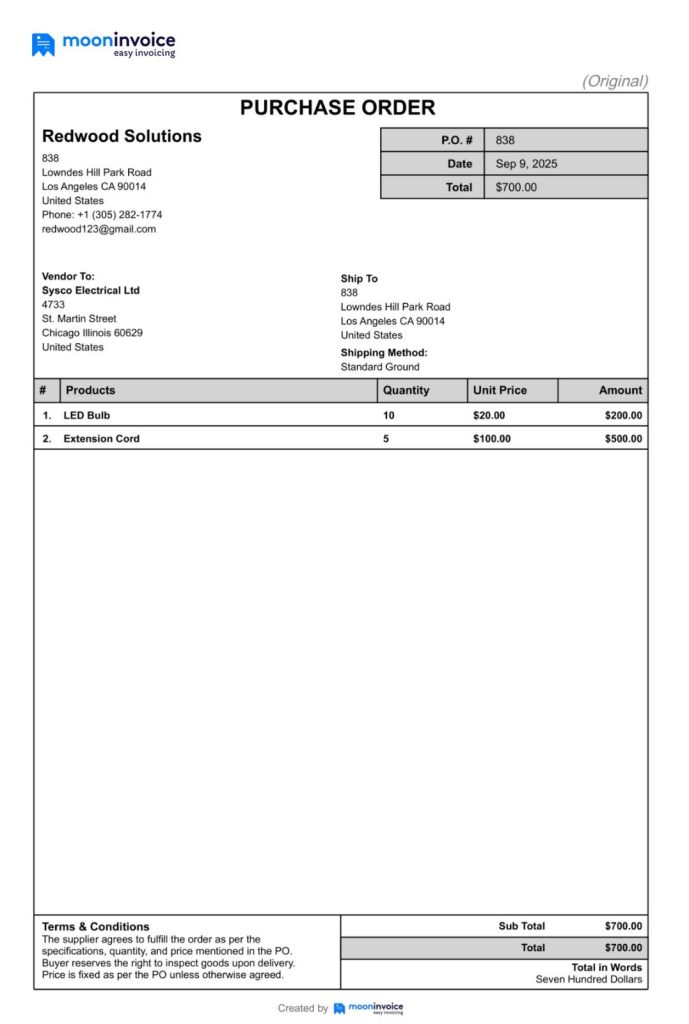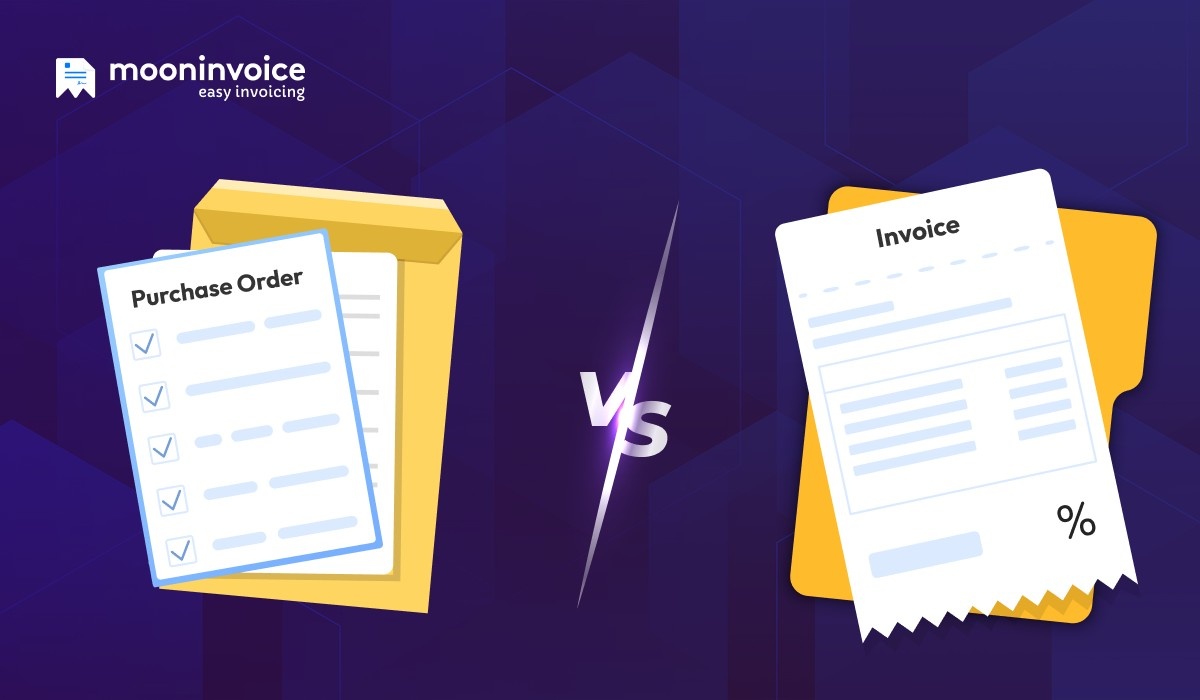Various documents play an integral role in the business billing process, and a purchase order and an invoice are among them. However, despite their importance and value, these two documents can be even more confusing for many professionals.
Especially new professionals who recently entered the procurement arena often get confused between PO and invoice. Which document is useful for which purpose? Which document is generated first during the purchase process? These are some questions that create confusion among professionals.
If you are among those who have no clear understanding of the difference between a purchase order and an invoice, then you have landed on the right page. Here, we’ll present all the required knowledge of the purchase order vs the invoice. So, you’ll find the entire clarity on how PO is different from an invoice.
However, before finding the true answer to what the difference is between a purchase order and an invoice, we need to understand the meaning of both documents, their examples, and their value to the business. Let’s go ahead!
📌 Key Takeaways
- A purchase order is created by the buyer when there is a need for goods or services.
- The vendor/seller creates an invoice after providing the requested service or product to the customer as per the PO.
- PO is the initial part of the business transactions, whereas an invoice comes after a PO, reflecting the payment request.
- Key factors that segregate PO and invoice are purpose & timing, accounting role, impact on business, and approval process.
- Both a purchase order and an invoice are helpful in tracking financial transactions of the business.
The purchase order software market is anticipated to reach USD 8.2 billion by 2033, and the e-invoicing software market size is projected to reach around USD 22.5 billion by 2033.
What Is a Purchase Order?
A Purchase Order is a formal business document that a buyer creates and shares with the vendor or supplier to purchase products or services at an agreed-upon price and specific quantity.
Creating a purchase order properly helps ensure that all necessary details are included and the process runs smoothly. However, in many organizations, especially large companies, a purchase requisition is created to obtain approval from higher authorities. Once it is approved, it is converted into a PO and shared with the vendor through a purchase order process that ensures proper authorization.
Once the vendor or seller accepts the purchase order, it becomes a legally binding contract. Finally, the vendor sends the requested items or services to the buyer as specified in the PO details, including the quantity and prices. Many modern companies rely on purchase order software to simplify this workflow.
Key Details to Include in the Purchase Order:
- PO number (unique for every new purchase order)
- Order date
- Vendor details – name, address, and contact details
- Client details – name, address, and contact details
- Billing address and shipping address
- Details of required items with quantity and unit price
- Total amount after inclusion of tax (if any)
- Expected delivery date, shipping address, and delivery method
- Terms and conditions
- Authorized signature of the buyer
Purchase orders are very common in large companies where there is a high demand for required items. In such companies, the procurement team is responsible for purchase order management. However, the need for a purchase order is very low in small businesses.
What Does a PO Look Like? An Example

Now Manage Your Purchase Ordering Like Never Before
Digitalize your PO generation and enhance your buying experience with Moon Invoice.
Why Is a Purchase Order Important for the Business?
After defining what a purchase order is, we now see its value in the business. A purchase order plays a valuable role in the procurement process of any business, regardless of its size or nature.
Set Clarity & Transparency
A professional purchase order establishes clarity and transparency in the purchasing process. By outlining the details of required items along with their quantities, it serves as a bridge between the client and vendor, facilitating clear communication.
Improves Inventory Management
Business professionals can easily manage their inventory with a purchase order. Professionals can prevent overstock or understock by cross-checking the quantity of goods in the PO. The integration of the PO generator with purchase order tracking and inventory management smooths this process.
Enhance Finance Management
A purchase order is helpful in tracking financial management. It includes all the details of the purchased items and services. With PO, companies can easily manage their purchasing flow, expenses, and forecast their budget. It also prevents unauthorized or fraudulent purchases.
Prevents Future Discrepancies
As a purchase order becomes a legally binding document after acceptance by the vendor, it reduces the chances of disputes. It reflects the agreement of both parties (vendor & buyer) on the whole purchasing process.
What Is an Invoice?
An invoice is a financial document that a seller or vendor generates and shares with the client or buyer to request payment for the product or service sold to the buyer. It outlines all the details of line items, including the unit price, applicable tax, and total due payment. Therefore, it is an official request to initiate the payment process.
Key Details to Include in the Invoice:
- Invoice number, invoice date, and due date
- Seller’s details – name, address, and contact details
- Buyer’s details – name, address, and contact details
- Description of listed items/services with unit price
- Taxes and discounts (if applicable)
- Accepted payment methods
- Payment terms
- Total payable amount
- Authorized signature of vendor/seller
Invoices make sure your business’s cash flow is managed smoothly. Business professionals can easily streamline their invoicing using the online invoicing software.
What Does an Invoice Look Like? An Example

Why Is an Invoice Important for the Business?
Apart from healthy cash flow, maintaining the financial health of the company, invoices are important in the following ways:
Enhance Auditing
An invoice document is a crucial document for the financial audit of a business. The financial team can easily determine whether the company’s financial statements are accurate and compliant.
Fraud Prevention
An invoice showcases the required details. Professionals can easily verify the details and match them against the purchase order to ensure the correct payment has been made to the right vendor. This process becomes even more effective when automation is integrated into the invoicing process.
Ease the Taxation
Invocies are useful for taxation purposes and simplify the same. Businesses can easily claim taxes when they have a professional and correct invoice that clearly represents the applicable tax details. It also prevents penalties during tax audits.
Supporting Evidence
Invoices are strong supporting documents for the business. They serve as strong evidence of the business transactions that occur between the buyer and seller. This streamlines the whole process and also reduces the chances of discrepancies.
💡Continue Reading:
Purchase Order vs Invoice – Key Differences
After understanding the meaning of a purchase order and an invoice and their value to the business, we now examine the key differences between a PO and an invoice. The following are the key points of PO vs invoice:
1. Need of Creation & Purpose
The basic difference between a purchase order and an invoice lies in when they are issued and why they are created.
The buyer creates a purchase order to initialize the procurement process. It means it takes place before the delivery of goods and services. The buyer shares it with the seller, reflecting the needs for goods and services, along with the order quantities and prices.
On the other hand, an invoice comes after the purchase order. The seller creates an invoice once the goods and services are delivered to the buyer. The invoice intends to request and collect payments from the buyer for the purchased goods and services.
A purchase order is a document that requests a purchase, and an invoice is a document that requests payment.
2. Content & Information Included
This is another important point to consider when comparing an invoice vs. a PO. Although both a PO and an invoice contain some similar information, some details distinguish them.
A purchase order and invoice typically have the same buyer and seller information. The line item details are also similar.
However, the following points justify the difference between a purchase order and an invoice in terms of content:
- The date of issuing the purchase order and the invoice is different from each other.
- PO contains the PO number, while the invoice contains the invoice number.
- A purchase order outlines the terms and conditions of the purchase, while an invoice outlines the payment terms of the invoice.
- The signature on the PO is of the buyer. Whereas the invoice contains the signature of the seller/vendor.
- An invoice contains a due date, whereas this information is not included on the PO.
- A purchase order does not specify the acceptable payment methods, whereas an invoice does.
A purchase order focuses on the buyer’s requirements, whereas an invoice contains the seller’s billing details.
3. Legal and Accounting Role
The other key difference between a purchase order and an invoice is their role in the legal process for the companies.
A purchase order becomes a legally binding document when accepted by the seller/vendor. It means the buyer and seller have agreed on the purchasing details mentioned on the purchase order.
On the other hand, an invoice is not a legally binding document itself. However, it plays a vital role as a supporting document during the legal process. There is a need for a separate underlying legal agreement to legalize an invoice.
Both purchase orders and invoices play a crucial role in the accounting process and legal actions.
4. Impact on Business Workflow
This is another important point regarding the topic of invoice vs. purchase order. Both documents also differ in their impact on the business workflow of a transaction.
A purchase order is used to initiate the deal. The buyer tells the supplier about the exact requirement. With a purchase order system in place, inventory planning becomes easier, and it ensures that internal approvals are obtained before making any payment.
In contrast, an invoice is generated in the final stages of the business workflow, i.e., after delivery. An invoice initiates the payment cycle and closes it once the payment is complete.
PO and invoice together streamline operations and ensure accountability from start to finish.
5. Approval Process
The approval process is another area that segregates purchase orders from invoices. It is one of the crucial points when comparing an invoice vs a purchase order.
➝ PO Approval Process
In case of a large procurement process, a PO is created, and the purchase order approval is done before any further process takes place. It includes key details such as the required items or services, quantity, agreed-upon price, and expected delivery date.
Here’s the approval chain of a purchase order:
- A purchase request is created by the purchasing department or employees and sent to the higher authority within the organization.
- The finance manager or accounts head checks everything and evaluates the expected overall cost.
- Once everything is fine and approved, the purchase request is converted into a PO.
- It is then shared with the supplier.
➝ Invoice Approval Process
The invoice approval process begins when the seller delivers the items to the customer. The accounts payable department reviews the invoices and cross-checks all the details.
Here’s how invoice approval is done:
- The seller issues the invoice, highlighting that the order has been fulfilled.
- The buyer then reviews it, considering both the purchase order and goods receipt note (GRN). This is referred to as a three-way invoice match.
- When everything is up to the mark and there is no mismatch between the documents, the financial team initiates the payment process. However, in case of any discrepancies, they investigate the matter.
PO vs Invoice in Tabular Form
| Aspect | Purchase Order | Invoice |
|---|---|---|
Don’t Let a Wrong Invoice Be the Cause of Your Stress
Moon Invoice is a treasure trove of 66+ invoice templates – customized, printable, and digital sending options. Want to avail them all?
Key Similarities Between Purchase Order and Invoice
So far, we have covered sufficient information on the topic of purchase orders vs invoices. Now, we check out some similarities between the two documents. Here are key similarities between a purchase order and an invoice:
- Purchase orders and invoices are important for a financial audit.
- Both documents contain the buyer and seller details.
- POs and invoices play a crucial role in the legal process and in preventing disputes.
- The line item details, including quantity and price, are included in both documents.
- PO and invoice are a crucial part of the procurement process.
- Both documents act as a record of the transaction.
Digitalize Your Procurement Process With Moon Invoice
Moon Invoice is a renowned name in the realm of PO creation and invoicing. Along with the creation of the professional PO and invoice, it provides a one-to-one solution for managing them effectively.
Streamline Your Purchase Ordering
Moon Invoice enables professionals to create a professional purchase order by providing a free purchase order template. The readymade samples help professionals create a professional PO in a minute by filling out the purchase order form. Additionally, professionals can avail themselves of the following features:
- Converting a PO into a bill in a single click
- Duplicate purchase order as PO, invoice, estimate, and proforma invoice
- Activity log to check every performed action
- Sharing of the PO via WhatsApp or email
- PDF and print settings
- Adding a digital signature
Streamline Your Invoicing
In addition to the purchase order, Moon Invoice streamlines the invoicing process by serving as the best online invoice generator. It helps professionals speed up their invoicing process and save time by adopting a digital concept.
Professionals can create professional invoices in less time using customized & free invoice templates. Thus, it is possible to generate the desired invoice cost-effectively. Moreover, you can perform the following tasks to manage your invoice effectively:
- Duplicate as invoice, estimate, proforma invoice, credit note, and purchase order
- Easily mark as paid, void, and sent
- Activity log to check every performed action
- Sending invoices via WhatsApp or email
- PDF and print settings
- Adding a digital signature
- Automated payment reminders
Wrapping Up
So, here we are terminating the story of the purchase order vs the invoice. Keep in mind that a purchase order and an invoice are both important documents for any business, and it is essential to be aware of their differences. A lack of familiarity or limited knowledge of such concepts can have a negative impact on your business procurement process, leading to mismanagement and financial suffering.
Digitalizing your procurement process is another way to approach enhancing your business flow. Try Moon Invoice and experience the power of AI and digitalization in your business accounting.



















